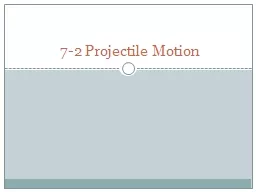

72 Projectile Motion Independence of Motion in 2D Projectile is an object that has been given an intial thrust ignore air resistance Football Bullet Baseball Moves through the air under the force of gravity ID: 761120
Download Presentation The PPT/PDF document "7-2 Projectile Motion Independence of Mo..." is the property of its rightful owner. Permission is granted to download and print the materials on this web site for personal, non-commercial use only, and to display it on your personal computer provided you do not modify the materials and that you retain all copyright notices contained in the materials. By downloading content from our website, you accept the terms of this agreement.
7-2 Projectile Motion
Independence of Motion in 2-D Projectile is an object that has been given an intial thrust (ignore air resistance) Football, Bullet, Baseball Moves through the air under the force of gravity Path is called Trajectory If you know the force of the thrust, you can determine trajectory
Independence of Motion in 2-D If you hit a golf ball, throw a football, only force acting on the projectile is gravity (long range) Gravity acts same in vertical direction Horizontal force has no effect on vertical component
Combination of vertical drop and horizontal moment give object a parabola trajectory
Strategy Separate into vertical and horizontal motion problem Vertical motion is treated like a straight up or down movement ( g ) Horizontal motion treated like a constant velocity problem No thrust and air drag neglectedNo horizontal forces acting (a = 0) Motions are connected by time variable Solve for time in one of the dimensions and will give you other
Equations Y-direction: v y = - gt y = y0 – (1/2)gt 2 t = √ -2(y – y 0 ) g X-Direction x = x 0 + v x0 t
Stone is thrown horizontally at 15 m/s from top a cliff 44 meters high A) How far from the base of the cliff does the stone hit the ground? Known X 0 = 0 v x0 = 15 m/s y 0 = 0 v y0 = 0 a = -g Unknown X when y = -44 m V at that time a F g = Fnet
How far from the base of the cliff does the stone hit the ground? Y-direction y = y0 – (1/2)gt2 t = √ -2(y-y0) so: = √ -2(y) / g g √ -2(-44 ) / -9.8 m/s2 = 3.0 sec
How far from the base of the cliff does the stone hit the ground? X direction x = x 0 + v x0 tx = (15 m/s)(3.0 m/s) = 45 meters from the base
How fast is it moving the instant before it hits the ground? V y = - gt vx = -(9.80 m/s2)(3.0 s) = -29 m/s v y v v = √ v x 2 + vy2 = √ (15 m/s)2 + (-29 m/s)2= 33 m/s
Projectiles Launched at an Angle Initial velocity has an initial horizontal and vertical component Rises with slowing speed and falls with gaining speed Max Height height of projectile when vertical velocity is zero and only has horizontal component y = y i + V yi t – (1/2)gt 2 Range (R) Horizontal distance the projectile travels
Problem A ball is launched with an initial velocity of 4.47 m/s at an angle of 66 o above the horizontal. A) What is the max height the object attained? B) How long did it take the ball to return to the launching height? C) What was the range? Known x i = 0 y i = 0 v i = 4.47 m/s θ = 66o a = -gUnknown y when Vy = 0 t = ?? x when y = 0
Equations Needed Y direction: V yi = vi sin θ (4.47)sin 66 o V yi = 4.08 m/s *** V y = V yi – gt *** y = yi + Vyit – (1/2)gt2 x direction V xi = v i cos θ V x = V xi x = x i + v xi t
What is the max height the object attained? V y = 0, t = v yi / g t = (4.08 m/s) / (9.80 m/s 2 ) t = 0.420 s y max = v yi t – (1/2)gt 2 = (4.08 m/s)(0.420) – (1/2)(9.80)(0.420) 2y max = 0.850 m
How long did it take the ball to return to the launching height? y = 0 y = y i + V yi t – ( 1/2)gt 2 0 = 0 + V yi t – (1/2)gt 2 t = 2v yi / g= 2(4.08 m/s) / (9.80)t = 0.83
What was the range? x = R R = V xi t = (4.47 m/s)(cos 66 o )(0.83 s) R = 1.5 m